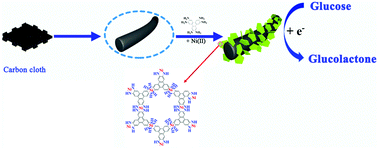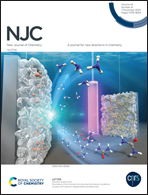A comparative study of electrocatalytic oxidation of glucose on conductive Ni-MOF nanosheet arrays with different ligands†
Abstract
The electrode design is of considerable importance for developing enhanced electrochemical sensing platforms. Conductive metal–organic frameworks (MOFs), with high surface area, high conductivity, and large pore volume, possess an ideal architecture for the detection of molecules. In this study, we report the first electro-oxidation of glucose in an alkaline solution using conductive Ni-based metal–organic framework nanosheet arrays on carbon cloth (Ni-MOF NSAs/CC) as a non-noble metal catalyst. Compared with a number of ligands coordinated to nickel salt, 2,3,6,7,10,11-hexaaminotriphenylene hexahydrochloride was selected as the best ligand to synthesize Ni-MOF because it has the highest electrocatalytic activity for glucose oxidation. The 3D Ni-MOF NSAs/CC electrode, as multifunctional sensors, was used to detect glucose with a low detection limit of 0.57 μM (S/N = 3), a wide linear range of 0.001–7 mM, high sensitivity of 13428.89 μA mM−1 cm−2, and good selectivity. The results demonstrate that the as-prepared Ni-MOF NSAs/CC has considerable development and application potential for clinical medical testing.



 Please wait while we load your content...
Please wait while we load your content...